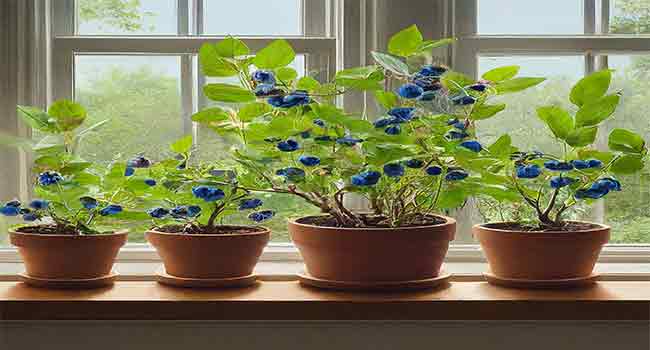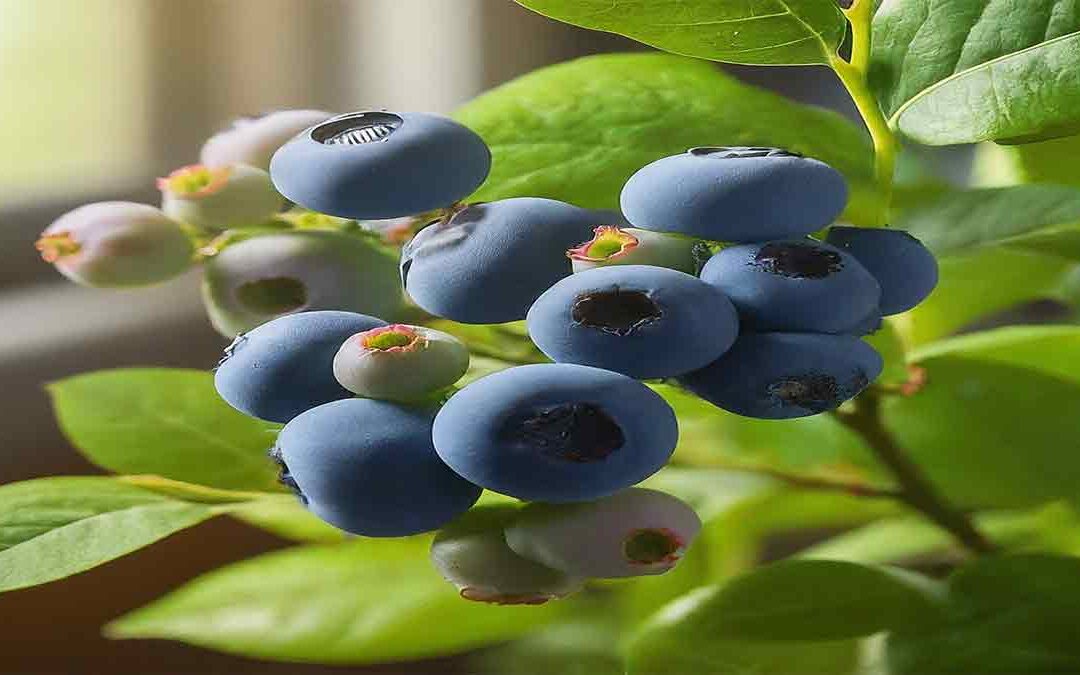Growing blueberries indoors might seem counterintuitive, but with a little know-how, you can transform your home into a thriving blueberry haven. Forget battling unpredictable weather, pests, or limited growing seasons. By bringing your blueberry bushes inside, you gain complete control over their environment, ensuring a bountiful harvest no matter what the calendar says.
Why Choose Dwarf or Lowbush Blueberries for Your Indoor Oasis?
The secret to successful indoor blueberry cultivation lies in choosing the right varieties. Opt for dwarf or lowbush blueberries, like the compact and productive ‘Top Hat’ or the vibrant ‘Sunshine Blue.’ These varieties are naturally smaller, making them perfectly suited for container gardening. Plus, their shallow root systems thrive in pots. And if you want to simplify things even further, consider self-pollinating varieties that eliminate the need for a second plant to produce fruit.
Crafting the Perfect Home for Your Indoor Blueberries: A Step-by-Step Guide
- Container Selection: Imagine your blueberry bush as a guest in your home. You want it to feel comfortable and have enough space to stretch out. Choose a pot that’s at least 12-18 inches in diameter and depth, allowing ample room for the roots to spread. Think of it as their very own studio apartment! Make sure it has plenty of drainage holes to prevent waterlogging – blueberries detest soggy roots. As for material, plastic, ceramic, or terracotta pots all work beautifully.
- Soil Preparation: Blueberries are a bit picky about their soil preferences. They crave an acidic environment with a pH between 4.5 and 5.5. This might sound technical, but it’s easy to achieve! Simply mix equal parts peat moss (their favorite), perlite (for airy soil), and compost (for nutrients). It’s like creating a gourmet meal for your blueberry plants, ensuring optimal growth and fruit development.
- Light Requirements: Just like us, blueberries love basking in the sun. Aim for at least 6-8 hours of direct sunlight each day. If your home doesn’t get enough natural light, don’t worry! You can create your own sunshine with full-spectrum grow lights. Imagine it as a personalized tanning salon for your blueberries, providing them with the energy they need to produce delicious berries.
- Temperature Considerations: Blueberries prefer moderate temperatures. During the day, keep them cozy at 65-75°F (18-24°C). At night, let them cool down a bit to 55-65°F (13-18°C). Think of it as their own personal thermostat, ensuring they stay comfortable day and night for optimal indoor blueberry care.
Nurturing Your Blueberry Babies: Planting and Initial Care
- Planting Instructions: Gently remove your blueberry plant from its nursery container and loosen the roots slightly. Plant it in your prepared pot, ensuring the crown (where the stem meets the roots) is level with the soil surface. Give it some space – about 2-3 feet apart if you’re planting multiple bushes. Water it well and let it settle into its new home.
- Watering: Blueberries enjoy moist soil, but not a swamp! Water them regularly, keeping the soil consistently damp but not soggy. Use rainwater or filtered water if possible, as blueberries are sensitive to chlorine. Think of it as giving them a refreshing drink, just like you’d offer a guest.
- Fertilizing: Blueberries are hungry plants, especially during the growing season. Feed them an acid-loving fertilizer (like ammonium sulfate) in spring and summer. Imagine it as a tasty treat, giving them the energy they need to produce delicious berries.
The Birds and the Bees of Indoor Blueberries: Pollination and Fruit Development
While indoor blueberries are sheltered from the elements, they still need a helping hand when it comes to pollination. This crucial step ensures a bountiful harvest of juicy berries.
- Importance of Pollination: Blueberries require pollination to produce fruit, a process typically carried out by bees and other insects in outdoor settings. However, indoors, you’ll need to take on the role of pollinator. Don’t worry, it’s easier than you might think!
- Hand-Pollination Techniques: To facilitate pollination, gently brush the flowers with a small paintbrush or cotton swab, transferring pollen from one flower to another. Aim to do this a few times a week during the blooming period. It’s a simple yet crucial step in ensuring a successful harvest. Consider it a delicate dance with your blueberry blossoms, fostering their potential to bear fruit.
- Signs of Successful Pollination: If your pollination efforts are fruitful, you’ll notice the flowers begin to drop off, and tiny green berries will start to form. This is a clear indication that pollination has occurred, and your blueberries are on their way to becoming plump, juicy delights.

Ongoing Care and Maintenance: Nurturing Your Blueberry Bushes into Berry-Producing Champs!
Once your blueberries are happily settled in their new home and have been successfully pollinated, it’s time to focus on their ongoing care. This is where your nurturing skills truly shine, ensuring your blueberry bushes thrive and produce a bountiful harvest.
- Watering Schedule: As your blueberries grow and the seasons change, their water needs will fluctuate. In the warmer months, they’ll likely need more frequent watering, while in the cooler months, you can scale back. Keep a close eye on the soil moisture – it should be consistently moist but not waterlogged. Consider using a moisture meter to gauge the soil’s dampness accurately. Remember, consistent moisture is key to healthy blueberry plants and optimal berry production.
- Fertilizing Routine: Just like athletes need proper nutrition to perform their best, blueberries require regular feeding to produce a bumper crop of berries. Continue fertilizing them with an acid-loving fertilizer throughout the growing season, typically from spring to summer. Look for fertilizers specifically formulated for blueberries or acid-loving plants. These will provide the essential nutrients your blueberries need to thrive and bear fruit.
- Pruning: Pruning is an essential aspect of blueberry care, both indoors and outdoors. It helps maintain the shape and size of your blueberry bushes, encourages new growth, and promotes better air circulation, which can help prevent diseases. Remove any dead or weak branches, and prune back any overly long shoots to encourage branching. Pruning also stimulates the growth of new fruiting wood, leading to more berries in the following seasons. Think of it as giving your blueberries a haircut, keeping them looking their best and promoting optimal berry production.
- Pest and Disease Prevention: Even indoors, blueberries can sometimes encounter pests like aphids or spider mites. Keep a vigilant eye out for any signs of infestation, such as discolored leaves or webbing. Address them promptly with organic control methods, like neem oil or insecticidal soap. Prevention is always better than cure, so ensure good air circulation and avoid overwatering, as these can create a breeding ground for pests and diseases.
The Sweet Reward: Harvesting and Enjoying Your Indoor Blueberries!
After months of nurturing and care, the moment you’ve been waiting for has arrived – harvest time! Get ready to savor the fruits of your labor.
- When to Harvest: Patience is a virtue when it comes to blueberries. Wait until the berries are plump, fully blue, and easily detach from the stem with a gentle tug. This usually happens in mid-summer, but with indoor growing, you might even get a second harvest in the fall!
- How to Harvest: Gently pick the ripe berries by hand, taking care not to damage the delicate branches. It’s a delightful experience, like a treasure hunt, searching for the plumpest, juiciest gems among the foliage.
- Storing and Using Your Harvest: Fresh blueberries are a delicious and healthy snack on their own, but they’re also incredibly versatile in the kitchen. Enjoy them in smoothies, pancakes, muffins, or even savory dishes like salads or salsas. Freeze any excess berries to enjoy their sweet goodness all year round. It’s the ultimate reward for your dedication and care.
FAQ: Your Questions About Growing Blueberries Indoors, Answered
To ensure your indoor blueberry journey is a success, we’ve compiled answers to some of the most frequently asked questions:
- Can I really grow blueberries indoors?
Absolutely! While blueberries are traditionally grown outdoors, with the right care and attention, they can thrive indoors year-round. Selecting suitable dwarf or lowbush varieties, providing ample light, maintaining acidic soil, and ensuring proper pollination are key to successful indoor blueberry cultivation.
- What are the best blueberry varieties for growing indoors?
Dwarf or lowbush varieties are ideal for indoor growing due to their compact size and shallow root systems. Popular choices include ‘Top Hat,’ ‘Sunshine Blue,’ and ‘Northblue.’ Consider self-pollinating varieties for ease of fruit production.
- Do blueberries need a lot of sunlight indoors?
Yes, blueberries love sunlight! Aim for at least 6-8 hours of direct sunlight daily. If your home lacks natural light, supplement with full-spectrum grow lights.
- How do I pollinate blueberry bushes indoors?
Since natural pollinators like bees are absent indoors, you’ll need to hand-pollinate your blueberry flowers. Gently brush the flowers with a small paintbrush or cotton swab, transferring pollen from one flower to another. Do this a few times a week during the blooming period.
- What kind of soil do indoor blueberries need?
Blueberries thrive in acidic soil with a pH between 4.5 and 5.5. Use a mix of peat moss, perlite, and compost to create a well-draining, nutrient-rich environment for your blueberry bushes.
- How often should I water my indoor blueberry plants?
Keep the soil consistently moist but not waterlogged. Check the soil regularly and water when the top inch feels dry to the touch. Use rainwater or filtered water if possible, as blueberries are sensitive to chlorine.
- Do indoor blueberries need fertilizer?
Yes, blueberries are heavy feeders and benefit from regular fertilization. Use an acid-loving fertilizer formulated for blueberries or acid-loving plants. Apply it according to the package instructions, typically during the growing season (spring and summer).
- Why aren’t my indoor blueberries producing fruit?
Several factors can affect fruit production, including insufficient light, lack of pollination, incorrect soil pH, or nutrient deficiencies. Ensure your blueberries receive adequate sunlight or supplemental lighting, hand-pollinate the flowers during the blooming period, maintain the correct soil pH, and fertilize regularly.
- Can I grow blueberries indoors in winter?
Yes! One of the advantages of growing blueberries indoors is the ability to enjoy fresh berries year-round, even in winter. With proper care and supplemental lighting, you can extend the growing season and enjoy a continuous harvest of delicious blueberries.
Conclusion:
Growing blueberries indoors is a rewarding journey that brings the joy of fresh, homegrown berries to your fingertips year-round. With the right knowledge and a little TLC, you can transform your home into a blueberry haven. So, what are you waiting for? Start your indoor blueberry adventure today and experience the satisfaction of growing your own delicious berries!
Remember, the key to success is providing your blueberry bushes with the optimal conditions they need to thrive. By following the tips and techniques outlined in this guide, you’ll be well on your way to enjoying a bountiful harvest of delicious, homegrown blueberries.
Read More
24 Amazing Blueberry Companion Plants to Boost Your Harvest
Life Cycle of Strawberry for a Bumper Crop
Humic Acid Benefits: 10 Natural Ways to Improve Your Harvest
Grow Blueberries Indoors: Easy Steps
Onion Growth Guide: 14+ Stages for a Bountiful Harvest

